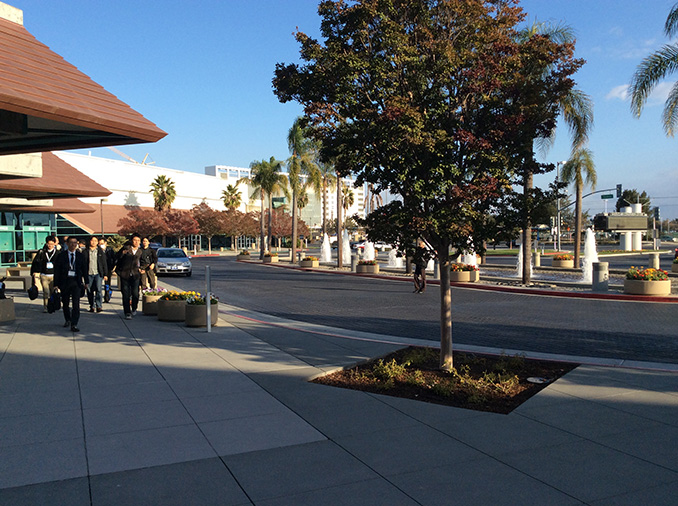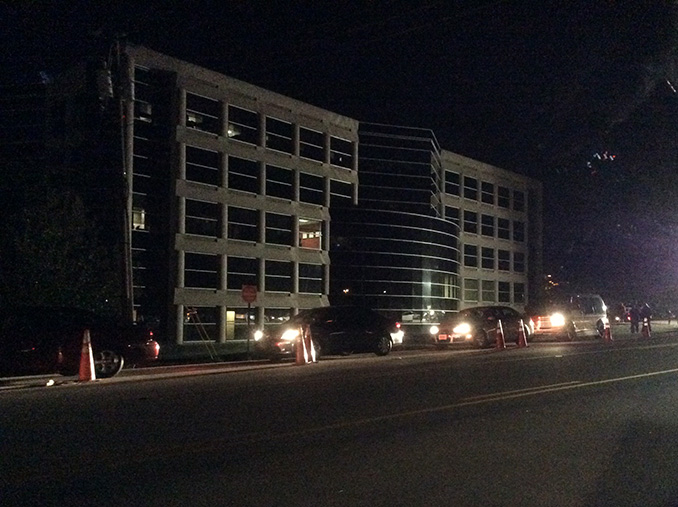The iPad Air Review
by Anand Lal Shimpi on October 29, 2013 9:00 PM ESTCamera
Front and rear facing cameras are necessary features on all modern, premium tablets. The usage model for a rear facing camera on a tablet is hopefully not as a primary image capture device but rather a convenient one. The idea being that if you’re on location somewhere using the iPad for work or play and need to quickly grab an image, having a decent rear facing camera can come in handy rather than having to put away your tablet, pull out your phone and then switch back afterwards.
Apple has improved its iPad imaging systems almost every single generation. That being said, the iPad Air is a bit of an exception to the rule as it retains the same rear camera sensor as the 4th generation iPad. We’re still talking about a 5MP sensor with f/2.4 lens, although the iPad Air now has a wider field of view with a 3.3mm focal length (identical to the original iPad mini).
| Rear Facing Camera Comparison | |||||||
| Sensor | Resolution | Aperture | Focal Length | ||||
| Apple iPad Air | 5MP | 2592 x 1936 | f/2.4 | 3.3mm | |||
| Apple iPad 4 | 5MP | 2592 x 1936 | f/2.4 | 4.3mm | |||
| Apple iPad 3 | 5MP | 2592 x 1936 | f/2.4 | 4.3mm | |||
| Apple iPad 2,4 | 0.7MP | 960 x 720 | f/2.4 | 2.0mm | |||
| Apple iPad mini | 5MP | 2592 x 1936 | f/2.4 | 3.3mm | |||
The rear facing camera tends to shoot at lower ISOs than the rear camera on the iPad 4. Since there’s no substantial change in the sensor or lens system however, the result is less noise but a darker image in low light situations. I suspect this might be more of a configuration default for the software layer driving the H6 ISP in Apple’s A7. Image quality is surprisingly good:
Even lower light shots come out fairly well:
Although obviously noise goes up appreciably once you get into really dark scenes:
I took a bunch of photos at the NC State Fair as well as on my trip out to Santa Clara following the iPad launch event in the gallery below.
Despite using the same ISP as the iPhone 5s, there’s no 10 fps burst capture mode on the iPad Air. Similarly there’s no slo-mo video recording mode either. The iPad Air does inherit the other benefits of the new H6 ISP however. Image capture is still insanely quick, which makes me wonder if the A7’s ISP also leverages that large on-die system cache.
| Front Facing Camera Comparison | |||||||
| Sensor | Resolution | Aperture | Focal Length | ||||
| Apple iPad Air | 1.2MP | 1280 x 960 | f/2.4 | 2.15mm | |||
| Apple iPad 4 | 1.2MP | 1280 x 960 | f/2.4 | 2.18mm | |||
| Apple iPad 3 | 0.3MP | 640 x 480 | f/2.4 | 1.8mm | |||
| Apple iPad 2,4 | 0.3MP | 640 x 480 | f/2.4 | 1.8mm | |||
| Apple iPad mini | 1.2MP | 1280 x 960 | f/2.4 | 2.2mm | |||
The front facing camera does see an improvement in sensitivity thanks to a larger sensor format. My understanding is this is the same sensor/lens combination as what’s in the iPhone 5s and 5c. Similarly to its implementation in the 5s, Apple seems to use the new front facing camera system to drive to lower ISOs and/or higher shutter speeds. You typically end up with a lower noise/sharper image, although sometimes there is a brightness/exposure tradeoff.
The other feature leveraged by the new front facing camera is the inclusion of a second microphone for noise cancellation. The goal here is to use the second mic to cancel out background noise and improve the quality of the audio you’re actually trying to record (presumably your voice during FaceTime for example). The impact is pretty noticeable. I ran an iPad 4 and an iPad Air side by side while playing a background track and have embedded the resulting videos below:
In the iPad Air sample video my voice comes across considerably clearer, as you’d expect given the Air’s second mic.
Video
Video capture settings look unchanged from the iPad 4. We’re still dealing with ~17Mbps High Profile videos from the rear camera and ~10Mbps Baseline Profile H.264 from the front camera.
Video quality out of both is pretty good for a tablet. In well lit scenes rear camera quality is definitely sufficient for sharing on the web.




















444 Comments
View All Comments
over9k - Tuesday, October 29, 2013 - link
Remember, Mavericks' big focus is RAM management. There's no reason to think iOS 7 also doesn't do some great RAM management. It's just that when talking mobile, that's not the "it" talk. Also, it's important to note that iOS devices have always used lower amounts of memory - they are just very well optimized.tipoo - Tuesday, October 29, 2013 - link
Mavericks borrowed how iOS already used memory, with background apps being able to be pushed out of memory if need be. iOS7 isn't getting Mavericks memory management, Mavericks is just getting the management iOS already had since its inception.kirsch - Tuesday, October 29, 2013 - link
I think over9k is referring to memory compression introduced in Mavericks. As far as I know this was never in iOS.tipoo - Tuesday, October 29, 2013 - link
The compression seems to work on idle apps too though, and iOS would run only one foreground app with most of the memory available to it. I just don't think it will help as much on a mostly single tasking OS.NetMage - Wednesday, October 30, 2013 - link
Actually it should help more as the recent Apps on iOS are mostly don't to run at all, but are kept in memory to improve swapping speed - these could be easily compressed with no impact on user experience.tipoo - Wednesday, October 30, 2013 - link
People saying Mavericks like compression will help: Anand measured how much RAM was in use under load. If it was compressing something, it would have been factored into how much was used. This is no holy grail here.darwinosx - Wednesday, October 30, 2013 - link
You think it needs 2 GB of ram why? It obviously doesn't. This isn't Windows or Android.DarkXale - Wednesday, October 30, 2013 - link
Because Safari is famous for resetting tabs (lost work), and many iOS apps are notorious for dropping undo states the very second you switch out of them. (Which you have to due to the inability to display more than one app at a time)Both cause data loss, which is one of the most serious events that can occur in computer systems.
Both are due to RAM constraints.
dugbug - Wednesday, October 30, 2013 - link
I have not seen that in ios7, they rewrote that behavior significantly. Would it benefit from more ram? sure. Or they could just rewrite it to cache tabs better.tipoo - Wednesday, October 30, 2013 - link
Because even with 30% less RAM use on 32 bit iOS, Safari boots tabs out like crazy and has to reload a lot of apps from NAND when switching.